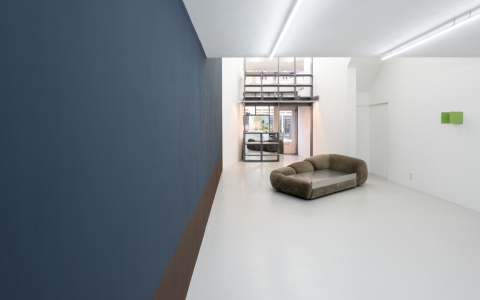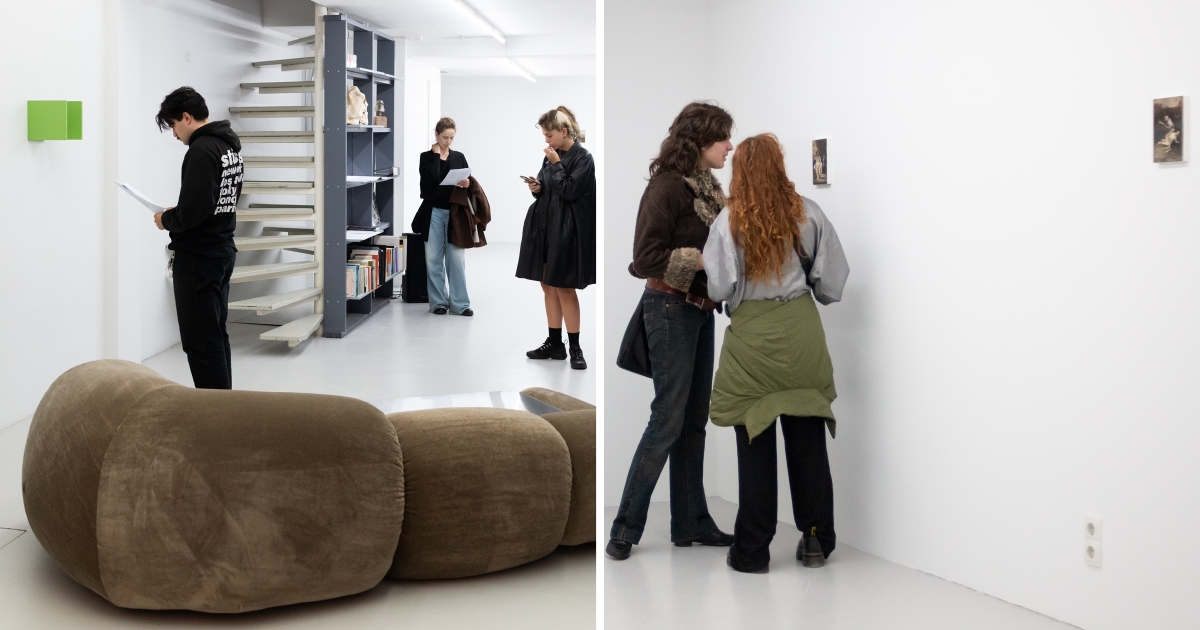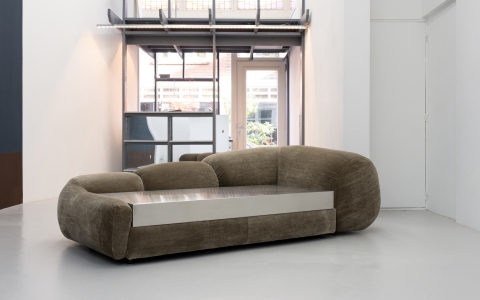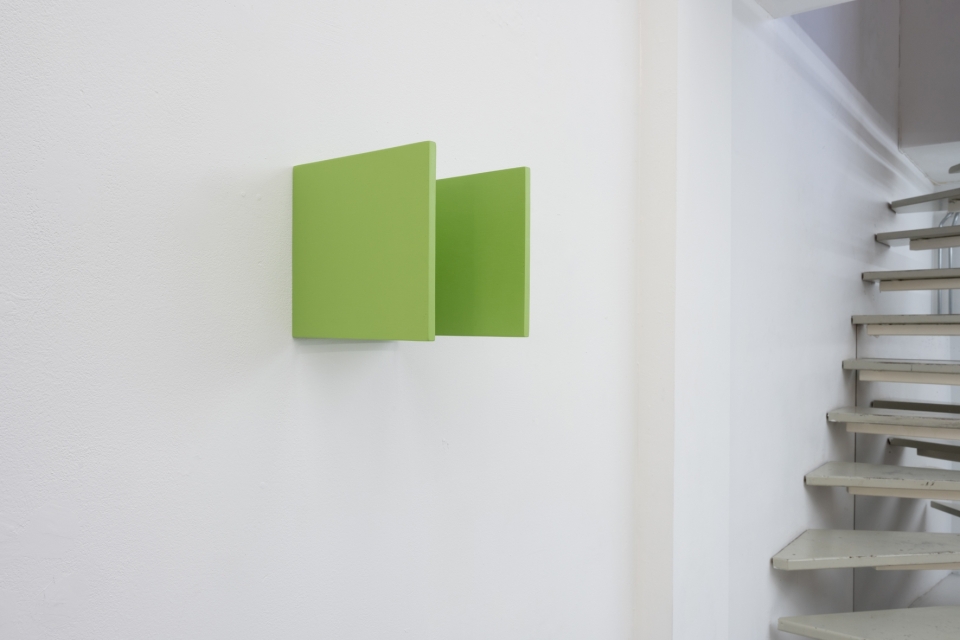Part 3: The Recipient
21.09.2024


Exhibition opening Volume III, Part 3: The Recipient, September 2024. Photos: Job Willems


Exhibition view Volume III, Part 3: The Recipient, September 2024. Photo: Lotte Stekelenburg


Exhibition opening Volume III, Part 3: The Recipient, September 2024. Photos: Job Willems


Bojan Šarčević, Slampadato, 2017, courtesy MANIERA, Brussels. Photo: Lotte Stekelenburg


Wooden pillow with drawer, anonymous artisan, Shandong (China), 1900, private collection of gerlach en koop. Photo: Lotte Stekelenburg
We welcome you to the third chapter of The Last Terminal, Volume III, titled The Recipient, a continuation of two parallel long term solo exhibitions: Om vijf uur? Slapen. by gerlach en koop (2024–) and Paintings by Lisa Ivory (2024–2025).
Paintings
Lisa Ivory (2024–2025)
Ivory’s paintings point to an evolving story with a seemingly clear narrative arc yet the stories do not easily yield to identifications and sympathies. They undermine our certainties about where we are in relation to what we are looking at. They lead one into a painterly universe; a shadow world, a natural habitat for nudes, skeletons, and domesticated monsters.
In Part 1: Beating Death With His Own Arm, we presented two paintings titled Tourist In Your Town and Love And Communication.
In Part 2: Errors, we presented three new paintings titled Foal Phantom, Hard Times, Call It Something Nice. All made in 2023.
In Part 3: The Recipient, we present three new works by the British artist Lisa Ivory (1966, London).
Om vijf uur?
Slapen.
gerlach en koop (2024–)
Sleeping can neither be learnt nor mastered. It’s an unpredictable force that cannot be forced. The sleepless are also powerless. Sleep is granted. The only thing one can do is imitate one’s own sleeping body, to re-stage the night before, hoping that at some point the copy will again be convincing enough to merge with the original – and that is when you fall …
In 2020 gerlach en koop displayed works by other artists in an exhibition approaching sleep at the GAK, Gesellschaft für Aktuelle Kunst in Bremen, Germany. During the year a faltered re-staging of this unusual solo-exhibition will unfold in the space of Rib. A few works at a time, two, three, maybe four. A full re-staging will follow, later on, in a somewhat larger space. Not all works exhibited in Bremen will be exhibited in Rotterdam however, and the ones that are will be changed by the very act of re-staging.
This third display will bring together three artworks and an artefact in an exhibition that also includes other works. All three have an author, certainly, we know the names – Kasper Bosmans, Jean-Luc Moulène, Bojan Šarčević – and all three have been made by someone who is not the author, we also know most of these names1 … but let’s forget names for now. We propose to consider the artworks for what they are, to look at them and look again, to take the time to see how they relate to each other, to the architecture, to the previous exhibitions in the space and to the darkness surrounding them that we have so carefully tried to protect and preserve.
Kasper Bosmans
The written instructions Kasper Bosmans gives to execute the mural No Water are very precise in some respects and very imprecise in others. All deliberate, of course. The specific hues for the blue and the brown and the height of their separation were to be decided upon by gerlach en koop. According to Bosmans the border between the two colours is not just a division; it is a horizon.
If you draw a line on a wall from left to right, saying ‘This is the horizon’ as the start of something – a story, a performance, a mural – then that line would only correspond to the real world for people who are exactly your height or, more precisely, people whose eyes meet yours exactly. This horizon would bind all of those people. Everyone else would see it as a representation of the horizon. They would follow along, but from an ever so slightly different perspective.
By drawing the horizon very low (say 60 centimetres) or very high (say 275 centimetres) we can be fairly sure that it will be a representation for everyone who visits the exhibition. For the paint gerlach en koop decided to approximate the brown hue in the eyes of a very specific person and the blue hue in the eyes of an equally specific other. They didn’t want to reveal the names when the work was executed the first time in Bremen, but could not keep their mouths shut then. So here they are, Andy Warhol and John Giorno, cameraman and protagonist of Sleep2.
Jean-Luc Moulène
In sleep, the brain still receives signals from the senses but they are blocked by the thalamus, the switching station that causes a kind of sensory blackout. You lose touch with reality completely. Your body is relaxed, even if some muscle tension is still present.
There are also periods during the night when the brain is as active as during the day, known as REM sleep, which is why it used to be called paradoxical sleep. When this happens, your body is not just relaxed but completely paralysed. This state is called ‘atonia’, the absence of tonus or muscle tension. Your skeletal muscles have no strength whatsoever. You can no longer move anything, you are trapped inside your own body3. Only muscles for automatic actions such as breathing still work, but at half strength. This paralysis is necessary because otherwise you would act out your dreams.
At this point, the thalamus can reopen the portal of the senses, but it is not sensations from the outside world that enter the cortex now, but your emotions, desires and memories, all of which are played back on the big screens of the visual, auditory and tactile parts of our brain.
And sometimes the timing is off.
You have already come to your senses, are in fact awake, while the atonia has not yet been lifted. Now you experience the terrifying sensation of a heavy weight on your chest – someone, or something sitting on it – making it difficult to breathe and no possibility to get rid of the thing. What causes this scary sensation is precisely the atonia that includes breathing at half strength.
On the other end, you may have already embarked on a violent dream even before atonia has set in, finding yourself in bed, kicking and beating about, screaming yourself awake.
Bojan Šarčević
He had visited this park a few times already. He didn’t make a habit of falling asleep in the middle of the day in an unfamiliar place and so he was frightened more than usual by this rather insignificant fact of having woken up there. On waking he paused for some moments; and although the situation itself wasn’t threatening at all, he still felt a little sick. After all, he found himself pressed – that was his word – against the slightly wet grass, possibly in the company of people he knew nothing about. The only voices he could hear were ones he didn’t recognize. Being frightened in that way was an old habit of his.
We forcibly pricked up our ears. Having been asked and after a few moments of uncertainty, he told us what it was that was holding him down. These were his words – he was convinced it was the arm belonging to someone else lying beside him resting across his neck, softly touching his cheek. He told us the arm was especially heavy. Grateful for this clarification, though not actually a satisfying one, he had then calmed himself down by convincing himself it wasn’t anything threatening. He even joked: ‘If an arm is the only thing pressing you to the ground, then at least you can search for a way out with your eyes wide open!’4
- 1In Bremen Head Box by Jean-Luc Moulène was on display, made by an unnamed Japanese craftsperson. In Rotterdam it will be the exhibition copy of the Head Box, which was made to be displayed for an entire year in a former donkey stable in Misileo, a small village in the hills of Tuscany. This stable was the temporary annex of lxhxb, the gallery of artist Guus van der Velden, who fabricated the copy.
- 2Sleep, a 321 minutes long, silent black-and-white film (16mm) that premiered on January 17, 1964 at the Gramercy Arts Theater in New York City.
- 3See Footnote 1.
- 4Fragment taken from ‘Almost as if he had’, a short story by Daniel Kurjakovic, in: Bojan Šarčević, Une Heureuse Régression, Kunstverein München, Köln: Snoeck Verlag, 2004, p. 332
Lisa Ivory lives and works in London. Solo exhibitions include Beasts Beguiled, Museum of Witchcraft and Magic (Cornwall), Savage Gardens, Pamela Salisbury Gallery, New York, Vice, Malice, Lust and Cunning, Lubomirov-Angus-Hughes Gallery, London. Her work has been part of group exhibitions in London and overseas that include Ricco Maresca Gallery (New York), The London Art Fair (London), Charlie Smith (London), Saatchi Gallery (London), Fragment Gallery (Moscow) and Fabian Lang Gallery (Zurich).












